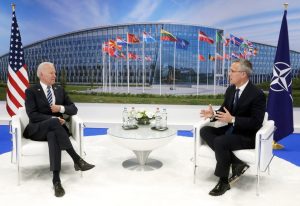China As A Security Risk: NATO:

The recently held North Atlantic Treaty Organization (NATO) summit for the first time has explicitly described China as a security risk.
- The other two threats identified by the NATO ‘declaration’ are Russia and terrorism.
North Atlantic Treaty Organization’s (NATO):
- Formation: NATO was established by the North Atlantic Treaty (also called the Washington Treaty) of 4th April, 1949, by the United States, Canada, and several Western European nations to provide collective security against the Soviet Union.
- It is headquartered at Brussels, Belgium.
- Political and Military Alliance: NATO’s primary goals are the collective defence of its members and the maintenance of a democratic peace in the North Atlantic area.
- The collective defence principle enshrined in NATO’s Article V states that “an attack against one ally is considered as an attack against all allies”.
- NATO’s Forces: NATO has a military and civilian headquarters and an integrated military command structure but very few forces or assets are exclusively its own.
NATO leaders declared China a constant security challenge and said the Chinese are working to undermine global order.
- This is in sync with US President efforts to get allies to speak out with a more unified voice against China’s trade, military and human rights practices.
- The US’ growing conviction is that China is a threat to its global supremacy and must be contained.
- However, both France and Germany sought to put some distance between NATO’s official position and their own perception of China.
- NATO’s European member states may view China as an economic rival and adversary, but they are unconvinced by the American line that it is an outright security threat.
China’s Stand: It has urged NATO to “view China’s development rationally, stop exaggerating various forms of ‘China threat theory’ and not to use China’s legitimate interests and legal rights as excuses for manipulating group politics artificially creating confrontations”.




